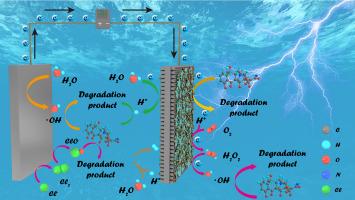2D MXene nanosheet dispersed Mn, Ru NPs loaded Ti composite electrodes for electrocatalytic synergistic degradation of antibiotics in high-salt mariculture wastewater
IF 8.3
1区 工程技术
Q1 ENGINEERING, CHEMICAL
引用次数: 0
Abstract
In this study, a composite electrode based on etched TiO2 nanotube arrays and two-dimensional (2D) MXene nanosheets was successfully designed for efficient degradation of antibiotics in mariculture wastewater. The composite electrode effectively dispersed Mn and Ru nanoparticles (NPs) by introducing 2D MXene nanosheets as an intermediate layer, which significantly enhanced the catalytic performance. The bifunctional properties of Mn and Ru NPs in catalysis and the contribution of d-orbital electrons to the formation of metal‑hydrogen bonds were revealed in depth by analyzing the electron transfer mechanism at the electrodes. The experimental results demonstrated a synergistic catalytic effect between Mn and Ru bimetals and MXene, resulting in an effective increase in the degradation rate. Under the optimal conditions, the degradation rate of Tetracycline (TC) by Mn/Ru/MXene/Ti composite electrode could reach 90.69 % in 60 min. In addition, it still shows excellent stability after 45 days of air exposure, 10 cycling experiments, and 10,000 s of timed current testing. Mechanistic studies have demonstrated that anode hydroxyl radical (·OH), HClO, and cathode activated hydrogen atoms (H*) all play catalytic roles in the degradation process. The degradation pathways were analyzed using density-functional theory (DFT) calculations and liquid-liquid-mass spectrometry (LC-MS) techniques, with further experiments confirming that this degradation process effectively reduces the biotoxicity of intermediate products, improving the safety of wastewater discharge. Finally, we designed the reactor and calculated the energy consumption to verify the feasibility and economy of the system in practical applications. This research proposes a novel multi-metal co-catalysis and cathode and anode co-catalysis system for the efficient degradation of antibiotics in mariculture wastewater, with potential applications in the electrocatalytic degradation of antibiotics.

二维 MXene 纳米片分散 Mn、Ru NPs 负载 Ti 复合电极用于电催化协同降解高盐海水养殖废水中的抗生素
本研究成功设计了一种基于蚀刻 TiO2 纳米管阵列和二维(2D)MXene 纳米片的复合电极,用于高效降解海水养殖废水中的抗生素。通过引入二维 MXene 纳米片作为中间层,该复合电极有效地分散了 Mn 和 Ru 纳米颗粒,从而显著提高了催化性能。通过分析电极上的电子传递机制,深入揭示了锰和钌纳米粒子在催化过程中的双功能特性以及d轨道电子对金属氢键形成的贡献。实验结果表明,Mn 和 Ru 双金属与 MXene 之间存在协同催化效应,从而有效提高了降解速率。在最佳条件下,Mn/Ru/MXene/Ti 复合电极在 60 分钟内对四环素(TC)的降解率可达 90.69%。此外,经过 45 天的空气暴露、10 次循环实验和 10,000 秒的定时电流测试后,它仍然表现出卓越的稳定性。机理研究表明,阳极羟基自由基(-OH)、HClO 和阴极活化氢原子(H*)在降解过程中都起到了催化作用。利用密度泛函理论(DFT)计算和液-液-质谱(LC-MS)技术对降解途径进行了分析,进一步的实验证实该降解过程能有效降低中间产物的生物毒性,提高废水排放的安全性。最后,我们设计了反应器并计算了能耗,以验证该系统在实际应用中的可行性和经济性。本研究提出了一种新型的多金属共催化和阴阳极共催化系统,用于高效降解海水养殖废水中的抗生素,在抗生素的电催化降解方面具有潜在的应用前景。
本文章由计算机程序翻译,如有差异,请以英文原文为准。
求助全文
约1分钟内获得全文
求助全文
来源期刊

Desalination
工程技术-工程:化工
CiteScore
14.60
自引率
20.20%
发文量
619
审稿时长
41 days
期刊介绍:
Desalination is a scholarly journal that focuses on the field of desalination materials, processes, and associated technologies. It encompasses a wide range of disciplines and aims to publish exceptional papers in this area.
The journal invites submissions that explicitly revolve around water desalting and its applications to various sources such as seawater, groundwater, and wastewater. It particularly encourages research on diverse desalination methods including thermal, membrane, sorption, and hybrid processes.
By providing a platform for innovative studies, Desalination aims to advance the understanding and development of desalination technologies, promoting sustainable solutions for water scarcity challenges.
 求助内容:
求助内容: 应助结果提醒方式:
应助结果提醒方式:


